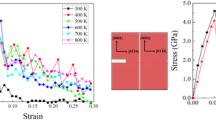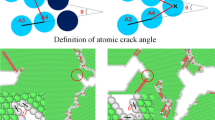Abstract
The deformation and failure mechanisms of γ-TiAl alloy with pre-existing crack and twin boundary are investigated by using molecular dynamics simulation. The effects of the crack position on the deformation and failure mechanisms of γ-TiAl specimen are analysed through the snapshots of crack propagation, microstructure of crack tip and stress-strain curves. The simulation results show that the dislocation motion is impeded, the good ductility can be maintained and the strength would be improved simultaneously by the twin boundary. The microstructure evolution of crack tip would change with crack positions. Essentially, the deformation behaviour mainly results from the reaction of dislocation-dislocation, dislocation-twin and twin-twin. Besides, the hierarchical twin is a main plastic deformation mechanism leading to strength of γ-TiAl specimen enhancement with non-compromising ductility and strain hardening. Based on stress-strain curves, it can be concluded that the yield strength varies with crack positions. They are the determinant factors for variation of the yield strength with different crack positions such as dislocation behaviour, stacking fault and hierarchical twin. The ductile-brittle transition associated with the dislocation motion and the decohesion failure of crack tip atom can be observed from the lower boundary crack and the center crack models. The crack propagation caused by the coalescent of the void and the crack tip is the main failure mechanism of γ-TiAl specimen. In addition, the results reveal that the mechanism of crack propagation would be influenced by pre-existing twin boundary which can prevent the crack propagation and improve the fracture toughness.
Similar content being viewed by others
References
Clemens H, Mayer S. Design, processing, microstructure, properties, and applications of advanced intermetallic TiAl alloys. Adv Eng Mater, 2013, 15: 191–21.
Marketz W T, Fischer F D, Clemens H. Deformation mechanisms in TiAl intermetallics—experiments and modeling. Int J Plasticity, 2003, 19: 281–32.
Clemens H, Smarsly W. Light-weight intermetallic titanium aluminides— status of research and development. AMR, 2011, 278: 551–55.
Bieler T R, Fallahi A, Ng B C, et al. Fracture initiation/propagation parameters for duplex TiAl grain boundaries based on twinning, slip, crystal orientation, and boundary misorientation. Intermetallics, 2005, 13: 979–98.
Wang H, Xu D S, Yang R. Implementing large-scale parallel atomistic simulations in the investigation of interfacial behaviors in titanium alloys (in Chinese). e-Sci Tech Appl, 2013, 33: 139–15.
Kim Y W. Ordered intermetallic alloys, part III: Gamma titanium aluminides. JOM, 1994, 46: 30–3.
Chen G, Peng Y, Zheng G, et al. Polysynthetic twinned TiAl single crystals for high-temperature applications. Nat Mater, 2016, 15: 876.881
Forwood C T. Slip transfer of deformation twins in duplex γ-based Ti-Al alloys. Part I. Transfer across γ-γ coherent twin interfaces. Philos Mag A, 2000, 80: 2747–278.
Zhao X, Lu C, Tieu A K, et al. Deformation mechanisms in nanotwinned copper by molecular dynamics simulation. Mater Sci Eng-A, 2016, 687: 343–35.
Kou H, Lu J, Li Y. High-strength and high-ductility nanostructured and amorphous metallic materials. Adv Mater, 2014, 26: 5518–552.
Sun L G, He X Q, Wang J B, et al. Deformation and failure mechanisms of nanotwinned copper films with a pre-existing crack. Mater Sci Eng-A, 2014, 606: 334–34.
Wei Y. Scaling of maximum strength with grain size in nanotwinned fcc metals. Phys Rev B, 2011, 83: 13210.
Zheng Y G, Zhang H W, Chen Z, et al. Roles of grain boundary and dislocations at different deformation stages of nanocrystalline copper under tension. Phys Lett A, 2009, 373: 570–57.
Wang Y M, Sansoz F, LaGrange T, et al. Defective twin boundaries in nanotwinned metals. Nat Mater, 2013, 12: 697–70.
Xie Y H, Xu J G, Song H Y, et al. Effect of twin boundary on nanoimprint process of bicrystal Al thin film studied by molecular dynamics simulation. Chin Phys B, 2015, 24: 02620.
Gao L, Song H Y, Sun Y, et al. Effects of twist twin boundary and stacking fault on crack propagation of nanocrystal Al. Comput Mater Sci, 2014, 95: 484–49.
Wen Y H, Wang Q, Liew K M, et al. Compressive mechanical behavior of Au nanowires. Phys Lett A, 2010, 374: 2949–295.
Deng C, Sansoz F. Near-ideal strength in gold nanowires achieved through microstructural design. ACS Nano, 2009, 3: 3001–300.
Song H, Li Y. Effect of twin boundary spacing on deformation behavior of nanotwinned magnesium. Phys Lett A, 2012, 376: 529–53.
Guo Y F, Xu S, Tang X Z, et al. Twinnability of hcp metals at the nanoscale. J Appl Phys, 2014, 115: 22490.
Zhou L, Guo Y F. Dislocation-governed plastic deformation and fracture toughness of nanotwinned magnesium. Materials, 2015, 8: 5250–526.
Song B, Guo N, Liu T, et al. Improvement of formability and mechanical properties of magnesium alloys via pre-twinning: A review. Mater Des (1980-2015), 2014, 62: 352–36.
Wang J, Li N, Anderoglu O, et al. Detwinning mechanisms for growth twins in face-centered cubic metals. Acta Mater, 2010, 58: 2262–227.
Guo Y F, Wang C Y, Zhao D L. Atomistic simulation of crack cleavage and blunting in bcc-Fe. Mater Sci Eng-A, 2003, 349: 29–3.
Wu W P, Yao Z Z. Molecular dynamics simulation of stress distribution and microstructure evolution ahead of a growing crack in single crystal nickel. Theor Appl Fract Mech, 2012, 62: 67–7.
Wu Z X, Zhang Y W, Srolovitz D J. Deformation mechanisms, length scales and optimizing the mechanical properties of nanotwinned metals. Acta Mater, 2011, 59: 6890–690.
Morris M A, Leboeuf M. II. Deformed microstructures during creep of TiAl alloys: Role of mechanical twinning. Intermetallics, 1997, 5: 339–35.
Teng C Y, Zhou N, Wang Y, et al. Phase-field simulation of twin boundary fractions in fully lamellar TiAl alloys. Acta Mater, 2012, 60: 6372–638.
Zope R R, Mishin Y. Interatomic potentials for atomistic simulations of the Ti-Al system. Phys Rev B, 2003, 68: 02410.
Xu D, Wang H, Yang R, et al. Molecular dynamics investigation of deformation twinning in γ-TiAl sheared along the pseudo-twinning direction. Acta Mater, 2008, 56: 1065–107.
Zhou Y, Yang Z, Lu Z. Dynamic crack propagation in copper bicrystals grain boundary by atomistic simulation. Mater Sci Eng-A, 2014, 599: 116–12.
Zhou M. A new look at the atomic level virial stress: On continuummolecular system equivalence. Proc R Soc A-Math Phys Eng Sci, 2003, 459: 2347–239.
Simkin B A, Ng B C, Crimp M A, et al. Crack opening due to deformation twin shear at grain boundaries in near-γ TiAl. Intermetallics, 2007, 15: 55–6.
Hao Y, Liu J, Li S, et al. Effects of nano-twinning on the deformation and mechanical behaviours of TiAl alloys with distinct microstructure at elevated loading temperatures. Mater Sci Eng-A, 2017, 705: 210.218
Song H Y, Li Y L. Atomic simulations of effect of grain size on deformation behavior of nano-polycrystal magnesium. J Appl Phys, 2012, 111: 04432.
Song H Y, Sun Y. Effect of coherent twin boundary and stacking fault on deformation behaviors of copper nanowires. Comput Mater Sci, 2015, 104: 46–5.
Wei Y, Li Y, Zhu L, et al. Evading the strength-ductility trade-off dilemma in steel through gradient hierarchical nanotwins. Nat Commun, 2014, 5: 358.
Ng B C, Simkin B A, Crimp M A, et al. The role of mechanical twinning on microcrack nucleation and crack propagation in a near-γ TiAl alloy. Intermetallics, 2004, 12: 1317–132.
Huang Z W, Bowen P, Jones I P. Transmission electron microscopy investigation of fatigue crack tip plastic zones in a polycrystalline γ-TiAl-based alloy. Philos Mag A, 2001, 81: 2183–219.
Fu R, Rui Z Y, Yan C F et al. Molecular dynamics simulation of micro-crack propagation behavior in single crystal γ-TiAl (in Chinese). J Funct Mater, 2015, 46: 13100–1310.
Yamakov V, Saether E, Phillips D R, et al. Dynamic instability in intergranular fracture. Phys Rev Lett, 2005, 95: 15502–1570.
Mine Y, Takashima K, Bowen P. Effect of lamellar spacing on fatigue crack growth behaviour of a TiAl-based aluminide with lamellar microstructure. Mater Sci Eng-A, 2012, 532: 13–2.
Xu S, Guo Y F, Wang Z D. Deformation mechanism of the single-crystalline nano-Cu films: Molecular dynamics simulation. Comput Mater Sci, 2013, 67: 140–14.
Holian B L, Ravelo R. Fracture simulations using large-scale molecular dynamics. Phys Rev B, 1995, 51: 11275–1128.
Rice J R. Dislocation nucleation from a crack tip: An analysis based on the Peierls concept. J Mech Phys Solids, 1992, 40: 239–27.
Zhou Z R, Wang Y, Xia Y M. Molecular dynamics study of deformation mechanism of γ-TiAl intermetallics. Acta Phys Sin-Ch Ed, 2007, 56: 1526–153.
Rice J R, Thomson R. Ductile versus brittle behaviour of crystals. Philos Mag, 1974, 29: 73–9.
Yamakov V, Saether E, Phillips D R, et al. Molecular-dynamics simulation-based cohesive zone representation of intergranular fracture processes in aluminum. J Mech Phys Solids, 2006, 54: 1899–192.
Wang G M. Molecular Dynamics Simulation of the Mechanical Behavior of Nanotwinned Copper (in Chinese). Dissertation for Master Degree. Hangzhou: Zhejiang University, 2011
Author information
Authors and Affiliations
Corresponding author
Additional information
This work was supported by the National Natural Science Fundation of China (Grant Nos. 51665030, 51865027), the Program for Changjiang Scholars and Innovative Research Team in University of Ministry of Education of China (Grant No. IRT_15R30), and the Doctoral Research Foundation of Lanzhou University of Technology.
Rights and permissions
About this article
Cite this article
Cao, H., Rui, Z., Chen, W. et al. Crack propagation mechanism of γ-TiAl alloy with pre-existing twin boundary. Sci. China Technol. Sci. 62, 1605–1615 (2019). https://doi.org/10.1007/s11431-017-9307-5
Received:
Accepted:
Published:
Issue Date:
DOI: https://doi.org/10.1007/s11431-017-9307-5




